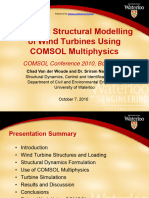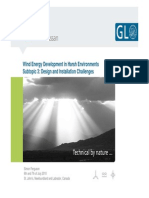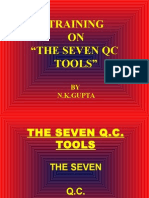Wind Turbines - Components and Design Basics PDF
Wind Turbines - Components and Design Basics PDF
Uploaded by
Thanasate PrasongsookCopyright:
Available Formats
Wind Turbines - Components and Design Basics PDF
Wind Turbines - Components and Design Basics PDF
Uploaded by
Thanasate PrasongsookOriginal Description:
Original Title
Copyright
Available Formats
Share this document
Did you find this document useful?
Is this content inappropriate?
Copyright:
Available Formats
Wind Turbines - Components and Design Basics PDF
Wind Turbines - Components and Design Basics PDF
Uploaded by
Thanasate PrasongsookCopyright:
Available Formats
Wind Turbines Components and Design Basics
Dr.-Ing. Stephan Matthiesen
Project Management
Dipl.-Ing. (FH) Meik Schacknies Design Department
Paris October 2009
Wind Turbines Components and Design Basics
Overview
Part I
Overview
Part II
Product range
Load assumptions for wind turbines
Components of a wind turbine
Loads and load cases
Rocking spring stiffness
Wind Turbines Components and Design Basics
Rated power:
Hub height:
330 kW
44 50 m
Rated power:
Hub height:
Rated power:
900 kW
45 m / 55 m Hub height:
800 kW
50 76 m
Wind Turbines Components and Design Basics
Rated power:
Hub height:
800 kW
73 m
Rated power:
Hub height:
2.300 kW
64 113 m
Rated power:
Hub height:
2.000 kW
78 138 m
Wind Turbines Components and Design Basics
Highest power producing WEC worldwide:
Rated power:
6.000 kW
Rotor diameter:
127 m
Hub height:
135 m
Power production:
20 Mio. kWh p.a.
Produces electricity for more than 5000 households
35% more yield compared to predecessor - E-112
Two-segment rotor blade facilitates transport
Wind Turbines Components and Design Basics
-> blades
-> nacelle with generator and
hub
-> tower (steel / concrete)
-> electrical installation and
grid connection
-> foundation
-> with piles or soil improvement
(if necessary)
Wind Turbines Components and Design Basics
-> blades
Wind Turbines Components and Design Basics
Wind Turbines Components and Design Basics
-> nacelle
Wind Turbines Components and Design Basics
-> steel tower
10
Wind Turbines Components and Design Basics
-> concrete
tower
11
Wind Turbines Components and Design Basics
-> foundation
with basket
12
Wind Turbines Components and Design Basics
-> foundation
with section
13
Wind Turbines Components and Design Basics
-> foundation
for concrete
tower
14
Wind Turbines Components and Design Basics
Overview
Part I
Overview
Part II
Product range
Design situations for wind turbines
Components of a wind turbine
Loads and load cases
Rocking spring stiffness
15
Wind Turbines Components and Design Basics
Design situations
Environmental conditions
Wind, Temperature, Ice, Earthquake
Operational conditions
Normal operation and power production
Start up, shut down, idling, standstill
Temporary conditions
Transportation of components
Installation and assembling
Maintenance and repair
16
Wind Turbines Components and Design Basics
Design load cases
Normal operation and normal external conditions
Normal operation and extreme external conditions
extreme wind speed
extreme direction change
extreme dynamic wind shear
nd
i
w
n
io
t
c
re
di
Fault situations and appropriate external conditions
Control system fault
Electrical fault
Yaw system fault
Transportation, installation and maintenance situations
17
Wind Turbines Components and Design Basics
Load cases for operational and environmental conditions defined in EN 61400-1
18
Wind Turbines Components and Design Basics
Due to the nature of wind the loads are high variable !
mean wind, gravity loads
(steady)
turbulence, earthquake
(stochastic)
unbalanced mass, rotor frequency (periodic)
start up / shut down, gusts
(transient)
Loads are calculated with special computation program in time domain.
Load calculations have to determined for each type separately.
[Hau 2005]
19
Wind Turbines Components and Design Basics
Different aspects for structural design
1.
Extreme Loads
(Ultimate Limit State)
2.
Fatigue Loads
(Ultimate Limit State)
3.
Stiffness of components
(ULS and SLS)
- Vibrations
(resonance effects)
- Deflections
(distance between blade and tower)
20
Wind Turbines Components and Design Basics
Vibrations - Rocking spring stiffness k,dyn
To avoid resonance we have to consider the stiffness of the components but also the soilstructure interaction. The eigenfrequency of the system machine - tower foundation - soil
shall not be in the range of the variable frequencies. To ensure this requirement a minimum
stiffness of foundation and soil is necessary.
System
:
Mass of WEC
Tower
Rotational spring stiffness
21
Wind Turbines Components and Design Basics
Important design parameter for WEC:
- Rotational frequency of rotor (1P)
- Rotational frequency of one blade (3P)
- Eigenfrequencies of the whole system (1. EF / 2. EF)
Eigenmodes of the tower structure
22
Wind Turbines Components and Design Basics
Merci pour votre attention
23
You might also like
- Machine Design Elements and AssembliesFrom EverandMachine Design Elements and AssembliesRating: 3.5 out of 5 stars3.5/5 (2)
- Abu Dhabi Capital DistrictDocument153 pagesAbu Dhabi Capital DistrictThanasate PrasongsookNo ratings yet
- How Do Vestas Manufacture Nacelles - PE Rev3Document67 pagesHow Do Vestas Manufacture Nacelles - PE Rev3tpzunigaNo ratings yet
- A Special Tribute Sheikh ZayedDocument44 pagesA Special Tribute Sheikh ZayedThanasate Prasongsook100% (1)
- MCQ MasterDocument11 pagesMCQ MasterMonzieAir67% (9)
- Silo Design Powdered Activated CarbonDocument187 pagesSilo Design Powdered Activated Carbonprasanth bhadran100% (2)
- Chilled Water Pump Head CalculationDocument6 pagesChilled Water Pump Head CalculationMohammed Hassan Mohiuddin Khan67% (3)
- Repower Offshore - Turbines and Uk MarketDocument35 pagesRepower Offshore - Turbines and Uk MarketKaio Dos Santos SilvaNo ratings yet
- 083 Moan Dynamic Analysis Wind TurbineDocument24 pages083 Moan Dynamic Analysis Wind TurbineAnonymous AbGkmW9No ratings yet
- Chapter Three PDFDocument36 pagesChapter Three PDFAdelu BelleteNo ratings yet
- 6-Doosan CigrePrep - 1222MVA GEN Development - FontRevID31VER89Document23 pages6-Doosan CigrePrep - 1222MVA GEN Development - FontRevID31VER89Yogananda Madhava SettyNo ratings yet
- Module3 1Document48 pagesModule3 1Sravan SatheeshNo ratings yet
- FM K12 12dfgdfgDocument23 pagesFM K12 12dfgdfgMuhammad AwaisNo ratings yet
- Module3 - 1 UpdatedDocument71 pagesModule3 - 1 UpdatedSravan SatheeshNo ratings yet
- CIVL4150 Engineer Practice Unit Resource Project - Aurecon: University of Western AustraliaDocument8 pagesCIVL4150 Engineer Practice Unit Resource Project - Aurecon: University of Western AustraliaKreen132No ratings yet
- Trial Lecture - Design Basis of Offshore Wind Turbines - Shallow and Deep Waters PDFDocument32 pagesTrial Lecture - Design Basis of Offshore Wind Turbines - Shallow and Deep Waters PDFjeovanNo ratings yet
- Short Course On Wind Energy - Multidisciplinary Design of Wind Turbine BladesDocument60 pagesShort Course On Wind Energy - Multidisciplinary Design of Wind Turbine BladesAlexandreSidantNo ratings yet
- Exercise 3Document8 pagesExercise 3kapoorkunal26No ratings yet
- ELG4126 Introductioto WindDocument38 pagesELG4126 Introductioto WindAnikesh DessaiNo ratings yet
- Wind Turbine ComponentsDocument28 pagesWind Turbine ComponentsMadhumita KaruppusamyNo ratings yet
- Wind Turbine Design ProcedureDocument4 pagesWind Turbine Design ProcedureEkambaramMuniyandi100% (1)
- Transformers Yesterday, Today & TomorrowDocument48 pagesTransformers Yesterday, Today & TomorrowFaiz Ahmed100% (2)
- Ae361 Project FinalDocument23 pagesAe361 Project FinalShafayat HussainNo ratings yet
- Unit III - RETDocument46 pagesUnit III - RETsagarpatil03012No ratings yet
- Wind Turbine Design Standards-DNV PDFDocument28 pagesWind Turbine Design Standards-DNV PDFarafard100% (1)
- 1.1 IntroductionDocument15 pages1.1 IntroductionAlphaBravoNo ratings yet
- Transmission Line Tower DesignDocument70 pagesTransmission Line Tower DesignArgaw Tadi100% (2)
- The Offline Wind Turbine Report-1Document11 pagesThe Offline Wind Turbine Report-1Kevin OnyangoNo ratings yet
- CEESP Electrical Energy Project Management 0 Intro To WPPDocument55 pagesCEESP Electrical Energy Project Management 0 Intro To WPPAbraham FernandezNo ratings yet
- Basic Principles of WECDocument70 pagesBasic Principles of WECSurya NarayananNo ratings yet
- Windenergieanlagen Broschuere eDocument8 pagesWindenergieanlagen Broschuere elolobidusNo ratings yet
- Tower PresentationDocument16 pagesTower PresentationtahaelnourNo ratings yet
- Wind TurbineDocument42 pagesWind TurbineAlaeddineNo ratings yet
- Wind Energy TechnologyDocument15 pagesWind Energy Technologytntntn86No ratings yet
- Steam Turbines Operation ServicingDocument8 pagesSteam Turbines Operation ServicingAwais KhalilNo ratings yet
- Powerhouse Roofing: Indian Institute of Technology RoorkeeDocument42 pagesPowerhouse Roofing: Indian Institute of Technology RoorkeeSwatantra KarnaNo ratings yet
- Helwan University Faculty of Engineering Dep. Electric Power and Machine EngineeringDocument37 pagesHelwan University Faculty of Engineering Dep. Electric Power and Machine EngineeringSamah MostafaNo ratings yet
- Wind Power PlantDocument36 pagesWind Power PlantAnonymous DMR58iAkP100% (1)
- Blade Design Methods and IssuesDocument48 pagesBlade Design Methods and IssuesEslam NagyNo ratings yet
- FLW S2P5 SummaryDocument10 pagesFLW S2P5 SummaryGion67No ratings yet
- Module 5pt1Document27 pagesModule 5pt1shamoon1985No ratings yet
- Day1 05 EllwoodDocument20 pagesDay1 05 EllwoodKimberly FieldsNo ratings yet
- Electrical LOADING DevicesDocument16 pagesElectrical LOADING DevicesOladokun Sulaiman Olanrewaju100% (1)
- VND - Openxmlformats Officedocument - Presentationml.presentation 0rendition 1Document35 pagesVND - Openxmlformats Officedocument - Presentationml.presentation 0rendition 1Safalsha BabuNo ratings yet
- 2 Chain DrivesDocument35 pages2 Chain DrivesMohammad UmairNo ratings yet
- Shahzad EITDocument27 pagesShahzad EITswaanNo ratings yet
- Alak Description Pelton TurbineDocument12 pagesAlak Description Pelton Turbinepavankumar001No ratings yet
- Hydro Media Media Center Iron Gates eDocument16 pagesHydro Media Media Center Iron Gates eShweta SankhlaNo ratings yet
- Van Der Woude PresentationDocument38 pagesVan Der Woude PresentationAnonymous lV8E5mEONo ratings yet
- Impact of Wind Energy On Power System Operation: Joris SoensDocument55 pagesImpact of Wind Energy On Power System Operation: Joris SoensBrzata PticaNo ratings yet
- Suzlonenergyfinal 111119124851 Phpapp01Document20 pagesSuzlonenergyfinal 111119124851 Phpapp01Bhimesh LavvanshiNo ratings yet
- Offshore Structural DesignDocument36 pagesOffshore Structural Designmesserklinge100% (1)
- Intenship Report Sumit Nagar PDFDocument14 pagesIntenship Report Sumit Nagar PDFSumit NagarNo ratings yet
- Wind EnergyDocument20 pagesWind EnergyShahanaAbdulRazakNo ratings yet
- Task 2qDocument7 pagesTask 2qoyetunde ridwanNo ratings yet
- PPTK FinalDocument18 pagesPPTK Finaltaquvuong1308No ratings yet
- Winding Manufacturing SiemensDocument22 pagesWinding Manufacturing Siemensmakwanagaurav185779No ratings yet
- Tower Crane PPT AniketDocument64 pagesTower Crane PPT AniketspcplaniketNo ratings yet
- Design and InstallationDocument27 pagesDesign and InstallationItzmichael EzNo ratings yet
- 1001 Mechanical Facts Made Easy - A Handbook Of Simple Mechanical Knowledge For Everyone Interested In The Work Of The EngineerFrom Everand1001 Mechanical Facts Made Easy - A Handbook Of Simple Mechanical Knowledge For Everyone Interested In The Work Of The EngineerNo ratings yet
- Aviation Engines Design—Construction—Operation and RepairFrom EverandAviation Engines Design—Construction—Operation and RepairNo ratings yet
- An Overview of Measures To Adapt Coal-Fired Power Plants To Flexible OperationDocument60 pagesAn Overview of Measures To Adapt Coal-Fired Power Plants To Flexible OperationThanasate PrasongsookNo ratings yet
- 115 Flexibility Report WEBDocument116 pages115 Flexibility Report WEBThanasate PrasongsookNo ratings yet
- Study On Independent Power Producers (IPPs) 2017Document155 pagesStudy On Independent Power Producers (IPPs) 2017Thanasate Prasongsook100% (1)
- An Overview of Measures To Adapt Coal-Fired Power Plants To Flexible OperationDocument60 pagesAn Overview of Measures To Adapt Coal-Fired Power Plants To Flexible OperationThanasate PrasongsookNo ratings yet
- Chapter 1 PPP Introduction and OverviewDocument180 pagesChapter 1 PPP Introduction and OverviewThanasate PrasongsookNo ratings yet
- Pea Grid Code (Eng)Document18 pagesPea Grid Code (Eng)Thanasate PrasongsookNo ratings yet
- Chapter 3 Project Identification and PPP Screening PDFDocument58 pagesChapter 3 Project Identification and PPP Screening PDFThanasate Prasongsook50% (2)
- Chapter 8 Operations and Handback PDFDocument54 pagesChapter 8 Operations and Handback PDFThanasate PrasongsookNo ratings yet
- PPP Certification Guide Foreword PDFDocument2 pagesPPP Certification Guide Foreword PDFThanasate PrasongsookNo ratings yet
- Cement & ApplicationsCPACDocument286 pagesCement & ApplicationsCPACThanasate PrasongsookNo ratings yet
- Precise CTDocument4 pagesPrecise CTThanasate PrasongsookNo ratings yet
- Annual Economic ReviewDocument52 pagesAnnual Economic Reviewmushmis333No ratings yet
- Looking Beyond The Obvious of BahrainDocument30 pagesLooking Beyond The Obvious of BahrainThanasate PrasongsookNo ratings yet
- Bahrain Economic Vision 2030Document26 pagesBahrain Economic Vision 2030Thanasate PrasongsookNo ratings yet
- Setting Up Business in BahrainDocument70 pagesSetting Up Business in BahrainThanasate Prasongsook100% (1)
- Abu Dhabi Fire Protection CodeDocument241 pagesAbu Dhabi Fire Protection CodeThanasate PrasongsookNo ratings yet
- Abu Dhabi Surface Transport Master PlanDocument100 pagesAbu Dhabi Surface Transport Master PlanThanasate PrasongsookNo ratings yet
- Plan Abu Dhabi 2030Document185 pagesPlan Abu Dhabi 2030Thanasate Prasongsook100% (1)
- Emirates Natural HistoryDocument344 pagesEmirates Natural HistoryThanasate Prasongsook100% (6)
- UAE Yearbook 2009Document341 pagesUAE Yearbook 2009Thanasate Prasongsook100% (1)
- Chemistry MSCDocument46 pagesChemistry MSCSunil KumarNo ratings yet
- 15 - Chapter 7 PDFDocument24 pages15 - Chapter 7 PDFpavan_1988No ratings yet
- Rook PolynomialsDocument4 pagesRook Polynomialsyrazs8021No ratings yet
- CBSE Class-12 Mathematics NCERT Exemplar Chapter - 7 INTEGRALS - Long Answer QuestionsDocument18 pagesCBSE Class-12 Mathematics NCERT Exemplar Chapter - 7 INTEGRALS - Long Answer QuestionsSweetha PrakashNo ratings yet
- Presentation On 7 Tools of Q.C.Document25 pagesPresentation On 7 Tools of Q.C.Jetesh DevgunNo ratings yet
- Rfet Analysis PDFDocument20 pagesRfet Analysis PDFAfiq Hashim100% (1)
- Tos Science 9 - 4thDocument8 pagesTos Science 9 - 4thJay Ronnie PranadaNo ratings yet
- Chopra 2019 Activitas Nervosa SuperiorDocument4 pagesChopra 2019 Activitas Nervosa SuperiorBryan MNo ratings yet
- Pile Foundation DesignDocument42 pagesPile Foundation DesignBright MuzaNo ratings yet
- Sky Realms of Jorune Isho TechnologyDocument15 pagesSky Realms of Jorune Isho Technologyy9x8c7v6b5n3100% (2)
- 2010 Aisc Steel ToolsDocument4 pages2010 Aisc Steel Toolsmuh2006No ratings yet
- RTHD Catalog RLC Prc020 enDocument32 pagesRTHD Catalog RLC Prc020 enCharles Lee50% (2)
- WDocument4 pagesWkenenathNo ratings yet
- Renè DescartesDocument4 pagesRenè DescartesTonNo ratings yet
- Earthquake Shake StudentDocument5 pagesEarthquake Shake Studentapi-254428474No ratings yet
- Phlebology PrereadingFridayDocument38 pagesPhlebology PrereadingFridayRubi ChanuNo ratings yet
- Situational Problems (Nikko Barongan)Document3 pagesSituational Problems (Nikko Barongan)Jonnah Faye MojaresNo ratings yet
- MAN - YuYao Gongyi - XMT808 - ENG PDFDocument22 pagesMAN - YuYao Gongyi - XMT808 - ENG PDFCsaba VargaNo ratings yet
- Ball-Milling in Liquid Media - Applications To The Preparation of Anodic Materials For Lithium-Ion BatteriesDocument92 pagesBall-Milling in Liquid Media - Applications To The Preparation of Anodic Materials For Lithium-Ion BatteriessegundosoporteNo ratings yet
- Davisson Germer LectureDocument21 pagesDavisson Germer LectureSyed Raheel AdeelNo ratings yet
- B7 Versus B16 BoltsDocument3 pagesB7 Versus B16 BoltsMichael SandersNo ratings yet
- HWK 6Document2 pagesHWK 6Pame GarciaNo ratings yet
- 5.1.CHM 3401 - Chromatography 1Document45 pages5.1.CHM 3401 - Chromatography 1anisghani100% (1)
- Igcse 43 Work&PowerDocument39 pagesIgcse 43 Work&PowerHany ElGezawy75% (4)
- 90Document1 page90Muhammad Junaid KhanNo ratings yet
- Coupling AlignmentDocument14 pagesCoupling Alignmentkutts76No ratings yet













































































































